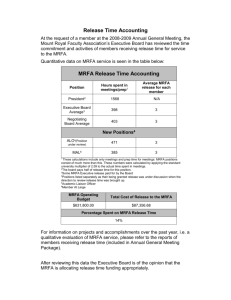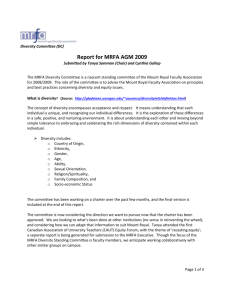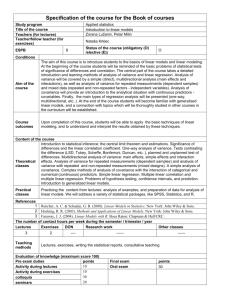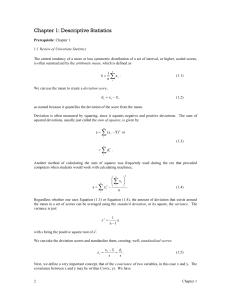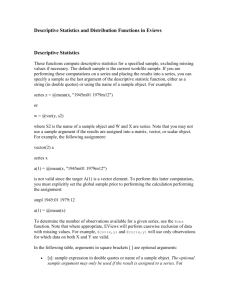mrfa
advertisement
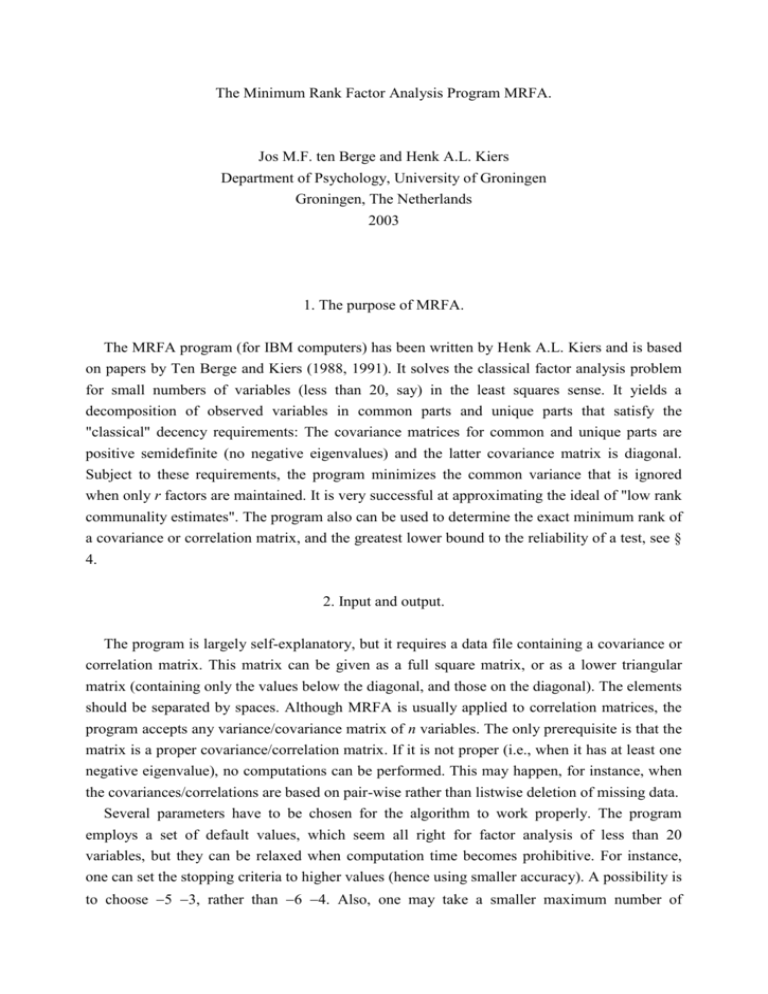
The Minimum Rank Factor Analysis Program MRFA. Jos M.F. ten Berge and Henk A.L. Kiers Department of Psychology, University of Groningen Groningen, The Netherlands 2003 1. The purpose of MRFA. The MRFA program (for IBM computers) has been written by Henk A.L. Kiers and is based on papers by Ten Berge and Kiers (1988, 1991). It solves the classical factor analysis problem for small numbers of variables (less than 20, say) in the least squares sense. It yields a decomposition of observed variables in common parts and unique parts that satisfy the "classical" decency requirements: The covariance matrices for common and unique parts are positive semidefinite (no negative eigenvalues) and the latter covariance matrix is diagonal. Subject to these requirements, the program minimizes the common variance that is ignored when only r factors are maintained. It is very successful at approximating the ideal of "low rank communality estimates". The program also can be used to determine the exact minimum rank of a covariance or correlation matrix, and the greatest lower bound to the reliability of a test, see § 4. 2. Input and output. The program is largely self-explanatory, but it requires a data file containing a covariance or correlation matrix. This matrix can be given as a full square matrix, or as a lower triangular matrix (containing only the values below the diagonal, and those on the diagonal). The elements should be separated by spaces. Although MRFA is usually applied to correlation matrices, the program accepts any variance/covariance matrix of n variables. The only prerequisite is that the matrix is a proper covariance/correlation matrix. If it is not proper (i.e., when it has at least one negative eigenvalue), no computations can be performed. This may happen, for instance, when the covariances/correlations are based on pair-wise rather than listwise deletion of missing data. Several parameters have to be chosen for the algorithm to work properly. The program employs a set of default values, which seem all right for factor analysis of less than 20 variables, but they can be relaxed when computation time becomes prohibitive. For instance, one can set the stopping criteria to higher values (hence using smaller accuracy). A possibility is to choose 5 3, rather than 6 4. Also, one may take a smaller maximum number of iterations. It should be noted, however, that when the maximum number of iterations is exceeded, no results are given for this particular run of the program. To prevent this, one should either set the stopping criteria to higher values (for a quick and dirty approach), or set the maximum number of iterations to a higher value (for an accurate but time consuming approach). A key question is how r, the number of factors, should be determined. This can only be answered by running the program several times and stepping r up or down according to the outcome. For instance, suppose we have 7 variables. We may start with r=2, and look at the unexplained common variance, which is the sum of the last 5 eigenvalues of R-U2, see § 3. When it amounts to 8% and we are not satisfied with this, we next try r=3. When, on the other hand 8% is considered very small, we may try r=1, to see if the unexplained common variance will still be small. The MRFA program may take a few minutes to converge, because it starts from n+1 different points, where n is the number of variables. After convergence, it is checked which runs led to the optimal solution, and to what extent these solutions differ. In case of large numbers of variables (above 20, say) computation times may become prohibitive. However, in such cases Principal Components Analysis is known to give essentially the same results, and can be used instead. The output of the program starts with some technical details, which may be ignored in most cases, and are mainly relevant for troubleshooting purposes (in particular, to inspect the runs that have failed to converge). The main part of the output is headed "SUMMARY of RESULTS" and contains the estimated communalities, and the eigenvalues of R-U2 (see § 3) for the best solutions (if any run converged at all). The sum of the last n-r of those is the criterion that is minimized by the program: It is the common variance that is left unexplained when the last (n-r) factors are ignored (we maintain only the first r factors !). The program gives also the unrotated common factor loading matrix A and a Normalized Varimax rotation of it. The MRFA program uses n+1 runs (unless r=0) and gives the above information for all solutions that reach the minimal amount of unexplained common variance. The reason that more than one solution is reported is that, in certain cases, different solutions attain the same unexplained common variance. Solutions are displayed fully when they differ by more than a prespecified amount (which can be modified) from already reported solutions. 3. Theoretical background. One of the optimality properties of Principal Components Analysis (PCA) is that it yields the best least squares approximation of an nn correlation matrix R by the product of an nn (n>r) matrix of component loadings A and its transpose: R=AA+E, with the sum of squared elements of E, abbreviated ssq(E), as small as possible given r. When r, the number of components, is increased, ssq(E) will decrease. In general, we do not get ssq(E)=0 unless we take as many components as we have variables (r=n). The idea of Factor Analysis is to disregard the diagonal elements of R and E and to find, for some small value of r, the nr loading matrix A which gives the best (least squares, or ML) fit to the off-diagonal elements of R. This idea is implemented by replacing the diagonal elements of R by so-called communalities of the variables. Specifically, we subtract a diagonal matrix U2 of unique variances from R. When R-U2=AA for some nxr matrix A, we have perfectly accounted for the off-diagonal elements of R. In practical applications, we are satisfied when AA is close to R-U2, in some sense. One particular class of Factor Analysis methods is Principal Factor Analysis (PFA). It is based on least squares approximation of R-U2 by AA. There is an the Unweighted Least Squares (ULS) procedure suggested by Jöreskog (1977), and a MINRES procedure suggested by Harman and Jones (1966). Computationally, these procedures are quite different. However, both are aimed at minimizing the sum of squared discrepancies between the off-diagonal elements of R and those of AA, where A is a nr loading matrix. Both procedures have a fundamental problem: Unless the off-diagonal elements of R are fully accounted for, the matrix R-U2 is likely to have some negative eigenvalues: the first r will be positive, but the smaller ones tend to be negative. Since these eigenvalues represent variances explained by factors, we get anomalous results. For instance, when we set r equal to the number of positive eigenvalues of R-U2, the r factors explain more than 100 % variance. Maximum Likelihood Factor Analysis (the ML option in LISREL) has similar problems. Another form of improper solution arises, even in cases of perfect fit, when U has a diagonal element higher than the corresponding diagonal element of R (a so-called Heywood case). The problems with improper matrices U are completely avoided by the MRFA method presented here. This is what MRFA accomplishes: After selection of a value r for the number of factors, MRFA determines the nonnegative diagonal matrix U such that the sum of the (n-r) smallest eigenvalues of (R-U2) is minimized subject to the constraint that they are nonnegative. This comes down to the following: By introducing U2, we split the observed variances (diagonal elements of R) in common parts (communalities), to be found on the diagonal of (RU2), and unique parts, to be found on the diagonal of U2. MRFA finds the split which is "proper" in every respect and minimizes the common variance that is ignored when we throw away the last n-r common factors. So it minimizes the lost information (=common variance unaccounted for) when we use only as few as r factors. Also see ten Berge (1998). Practical experience with MRFA indicates that it tends to give a unique solution for the communalities, although certain exceptions are known to exist. The program offers a check for non-unique solutions. However, rotation of the factor loadings is by all means possible. The program gives Varimax rotation throughout. 4. Sampling Bias Recently, the asymptotic bias of the unexplained common variance in MRFA, under the assumption of multivariate normality, has been estabished (Shapiro & Ten Berge, 2002). Even in small samples, there is no indication of bias, except when the number of factors is small. Further research into the bias of MRFA is underway (Socan, 2002, in preparation). 5. Special options of the program. a. The program can be used to compute the greatest lower bound (glb) to reliability as defined by Woodhouse and Jackson (1977), according to the algorithm suggested by Ten Berge, Snijders and Zegers (1981) as a modification of Bentler and Woodwards method (1980). This lower bound is better than coefficient alpha, but can only be trusted in large samples, preferably 1000 cases or more, due to a positive sampling bias. To get the glb, run the program with the number of factors r set to 0. Note that it may be necessary to reset the maximum number of inner iterations to a very high value, like 50000. b. The program can be used to determine the exact minimum rank of a covariance or correlation matrix. This has not much practical value, because the exact minimum rank tends to be closer to n than to 1, but may be needed in special cases, for instance, when variables are hypothesized to be a set of congeneric measures. The minimum rank is found as the smallest value of r for which the unexplained common variance is zero. In case of congeneric measures, a rank one solution should give a perfect fit. To see if that holds true, run the program with r=1, and the unexplained common variance of MRFA indicates how severely the rank one hypothesis is violated. It should be noted that having a covariance matrix with minimum rank 1 is necessary, but not sufficient for a set of measures to be congeneric. References Bentler, P.M. & Woodward, J.A. (1980). Inequalities among lower bounds to reliability: With applications to test construction and factor analysis., Psychometrika, 55, 249-267. Harman, H.H. & Jones, W.H. (1966). Factor analysis by minimizing residuals (Minres). Psychometrika, 31, 351-369. Jöreskog, K.G. (1977). Factor analysis by least squares and maximum likelihood methods. In K. Enslein,, A. Ralston, and H.S. Wilf (Eds.): Statistical methods for digital computers (Vol. 3), [125165]. New York: Wiley. Ten Berge, J.M.F. (1998). Some recent developments in Factor Analysis and the search for proper communalities. In A. Rizzi, M. Vichy & H.-H. Bock (Eds), Advances in data science and classification. Berlin: Springer. Ten Berge, J.M.F. & Kiers, H.A.L. (1988). Proper communality estimates minimizing the sum of the smallest eigenvalues of a covariance matrix. In M.G.H. Jansen & W.H. Van Schuur (Eds.): The many faces of multivariate analysis. Proceedings of the SMABBS88 Conference in Groningen [30-37]. Groningen: RION. Ten Berge, J.M.F. & Kiers, H.A.L. (1991). A numerical approach to the approximate and the exact mimimum rank of a covariance matrix. Psychometrika, 56, 309-315. Ten Berge, J.M.F., Snijders, T.A.B. & Zegers, F.E. (1981). Computational aspects of the greatest lower bound to reliability and constrained minimum trace factor analysis. Psychometrika, 46, 201-213. Shapiro, A. & Ten Berge, J.M.F. (2002). Statistical inference of minimum rank factor analysis. Psychometrika, 67, 79-94. Woodhouse, B. & Jackson, P.H. (1977). Lower bounds to the reliability of the total score on a test composed of nonhomogeneous items: II. A search procedure to locate the greatest lower bound. Psychometrika, 42, 579-591.
